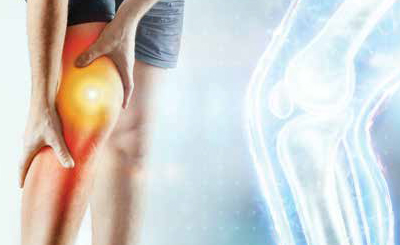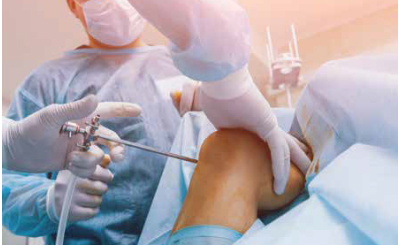With musculoskeletal conditions accounting for 12.6 per cent of global disabilities, keeping up with orthopaedic tech trends is crucial in modern medicine. Dr. Syed Imran outlines how emerging technologies, such as Trauma CAD, Templating Software, Holography, Robotics, Virtual Reality, and Google Lens, are imperative in preoperative planning and boosting surgery success.

Orthopaedic treatment has traversed a long way in the past years. Revolutionary innovations in technology continue to make treatments more precise, personalised, and less invasive. The greatest measure of success is clearly reflected in improved patient outcomes and quality of life.
1. Robotics and Computer-Assisted Surgery
2. 3D Printing and Custom Implants
3. Regenerative Medicine and Tissue Engineering
4. Virtual Reality (VR)
5. Wearable Technology and Remote Monitoring
Light-wiring polymer casts are made of silicon and photo resin. They are elastic and stretchable before use — meaning they can be moulded more precisely around an injury in order to set correctly. These casts are 100 per cent waterproof, washable and bathfriendly, comfortably cushioned, and well-ventilated. Furthermore, lightwiring polymer casts are lightweight and high strength, offering maximal uniform stress distribution.
Technological Trends: New Technology in Orthopaedic Treatments
The goal of robotics is the enhancement of joint replacement surgery
Robotic-assisted arthroplasty, often known as robotics in arthroplasty, is a fast-developing discipline that combines orthopaedic surgery and cutting-edge robotics technology. This strategy intends to increase the precision of joint replacement treatments. It allows surgeons to plan and execute surgeries with high accuracy, making procedures safer and more effective and improving patient outcomes. Accurate positioning and alignment of joint implants are critical for their long-term success. Robotics in arthroplasty surgery help reduce the risk of implant wear and loosening, potentially leading to longerlasting joint replacements. Scientific studies are needed to establish their claim in the long term.
In addition to their surgical implementations, there are also AI Robots being used in rehabilitation.
Platforms like Sword Rehab , Kaia Health , and Physitrack use therapy robots that can sense even the tiniest bit of progress and provide quantified information about incremental improvements. As the patient starts gaining strength and ability, the robot delivers less aid, enabling the patient to move with more confidence.
3D printing technology has revolutionised orthopaedics by enabling the creation of patient-specific implants, prosthetics, and surgical guides. Surgeons can now design and produce implants tailored to an individual's unique anatomy, leading to better outcomes and reduced intra-operative complications.
3D Models
3D models of the affected area can be used in pre-operative planning to increase precision and avoid complications during the actual surgery, greatly reducing risk to the patients. 3D modelling is also used in the development of porous metal implants and the creation of patientspecific instrumentation.
Regenerative Medicine and Tissue Engineering are interdisciplinary branches of science and medicine that concentrate on creating new methods to replace or restore harmed, deteriorated, or damaged body tissues and organs. By utilising the body's natural capacity for regeneration or by developing synthetic tissue substitutes, these sectors seek to restore normal tissue function.
While tissue engineering is a subset of regenerative medicine that focuses specifically on creating artificial tissues and organs in the lab for transplantation or research, regenerative medicine is a broad field that encompasses various approaches to stimulate the body's natural healing processes and replace or repair damaged tissues.
3D Bioprinting
A cutting-edge technology in the field of regenerative medicine, this process distributes cells, biomaterial, and supporting biological factors in a layerby-layer fashion to form living tissues and analogous organs. This medium of printing is composed of inert material that can support live cells. Examples include hydrogels, microcarriers, tissue spheroids, and tissue strands. Through the use of these materials, the metamorphosis of these cells into human tissue or organs is accomplished.
Cartilage Bioprinting
Cartilage bioprinting focuses on the development of methods to produce synthetic cartilage tissue using 3D bioprinting technology. It is part of regenerative medicine and tissue engineering. Cartilage is the connective tissue that cushions and supports joints like the knee, hip, and shoulder. It frequently has a low capacity for regeneration when damaged by an accident or degenerative diseases like osteoarthritis. Cartilage bioprinting seeks to solve this problem by producing functional, lab-grown cartilage that can be utilised for transplantation or for scientific research on cartilage biology.
Bone Bioprinting
Modern tissue engineering and regenerative medicine techniques called "bone bioprinting" are focused on employing 3D bioprinting to create artificial bone tissue. Bone bioprinting intends to produce functional bone structures for a variety of medicinal uses, such as bone repair, reconstruction, and regeneration. In order to accurately replicate the composition and characteristics of real bone tissue, bone bioprinting uses the exact deposition of biocompatible materials and living cells.

In order to improve patient care and outcomes, virtual reality (VR) technology is rapidly being used in orthopaedic therapy and rehabilitation. Orthopaedic patients can benefit from the immersive, interactive, and adaptable environments that virtual reality (VR) offers.
Even though virtual reality (VR) technology in orthopaedic treatment is constantly growing and evolving, it has already shown promise in terms of boosting rehabilitation outcomes, increasing patient involvement, and offering cutting-edge tools for both surgeons and physical therapists. As technology develops, it is likely to be incorporated more into standard orthopaedic care, bringing new advantages to both patients and healthcare professionals.
VR technology uses 3D imaging and databases to create a simulated interactive environment, typically using a head-mounted display. It is currently used in psychiatric therapy, pain management, rehabilitation, and to treat traumatic brain injury — among its many other applications in the field of medical treatments. Furthermore, it can be used for surgical training, pre-op planning, and intra-op navigation.
VR in Training for Arthroscopy
The use of VR for training in Arthroscopy — a surgical procedure used to detect and treat sports injuries is also gaining traction. However, it is important to note that, in its current stage, it comes with both advantages and disadvantages.
Advantages
Greatly adding to the potential benefit to patient safety, the technology aids in lowering the possibility of difficulties during actual procedures and enhances surgeon abilities acquired through VR training. Systems for monitoring and documenting a trainee's progress over time are frequently included in training platforms. This information can be helpful for determining a person's competency and certifying them for a particular technique.
Disadvantages
Since it is a nascent technology after all, VR in training for Arthroscopy requires a high level of expertise to implement. Furthermore, at this stage in time, the technology is only limited to certain procedures. A major disadvantage is cost, as this state-of-the-art technology does not often come cheap.
Use of Google Lens as an Intraoperative Intervention
Google lens studies acknowledge its potential for training, consultation, patient monitoring, and audiovisual recording. Picture recognition systems like Google Lens could very well have use in surgical interventions, given the rapid improvements in healthcare technology, including augmented reality (AR) and artificial intelligence (AI). However, the technology does come with several limitations.
Google Lens – Usefulness
Google Lens seems to provide the greatest benefit in surgical education. Short-distance, live streaming of surgeries by surgeons to trainees and its ability to provide augmented reality guidance in simulated surgeries has the potential to aid medical students in skill acquisition and task comprehension. The pros are ease of use, comfort, ability to aid attentiveness, and, most of all, image quality.
In a non-educational capacity — by offering real-time image analysis during surgery, image recognition technology may be able to help surgeons as it can aid in locating and emphasising particular structures, anomalies, or crucial areas in the surgical field. Furthermore, surgeons can exchange photos and videos of the operating room in real-time with colleagues or experts for remote advice and direction using image recognition technology.
Google Lens – Limitations
The technology comes with limitations that simply cannot be overlooked when it comes to medical and surgical applications. The cons include glaring issues such as short battery life,
"head tilt zooms" that can interfere with the seamlessness of delicate procedures and limited connectivity. Furthermore, major factors in terms of data protection, the confidentiality of sensitive information, and the patient's privacy in surgical or medical settings cannot be guaranteed without the intervention of regulatory bodies. The entire process is getting upgraded.
Remote monitoring and wearable technology are becoming more and more important in orthopaedic patient care and therapy. These innovations give orthopaedic patients the tools to evaluate their progress, get real-time feedback, and help medical professionals better monitor and take care of their patients' problems.
Wearable Technology
Fitness trackers and smartwatches are examples of wearable technology that may track a patient's daily activity levels, including steps taken, distance travelled, and calories burned. This data is useful for determining a patient's activity level and mobility after orthopaedic surgeries. Specific data related to orthopaedic diseases, such as joint range of motion, gait analysis, and muscle activation, can be monitored by advanced wearable information for evaluating the success of rehabilitation. Smart braces that have sensors and Bluetooth connectivity can keep an eye on joint pressure and movement. They give patients and their medical professionals real-time feedback to make sure the right rehabilitation exercises are being carried out.
Remote Monitoring
By giving patients access to data and comments in real-time, remote monitoring encourages patients to take an active role in their treatment. During rehabilitation, this may increase patient compliance and motivation. Healthcare professionals can analyse patterns and decide on a patient's treatment plan by using wearable technology and remote monitoring systems to collect and send data. For instance, alterations to rehabilitation regimens may be required if activity levels or gait patterns vary. When a patient reports greater pain or discomfort or when predicted progress deviates from what is expected, remote monitoring systems can warn healthcare professionals. This makes it possible for prompt treatment plan modifications and early intervention. Through video conferencing, physical therapists can supervise patients' exercise performance from the comfort of their homes during remote physical therapy sessions. The therapist can track development and modify the treatment strategy as necessary.
Technology adoption for better results and better outcomes is the norm of time, and it needs to be evaluated and tested before being applied. Presently, it is gaining acceptance across hospitals, surgeons and patients. In the world of information, with everything available at the click of a phone, medical innovation and technology need to be abreast with the whole technological ecosystem. I personally adapt to technology which is proven safe and sound to make patients achieve safer and better outcomes.